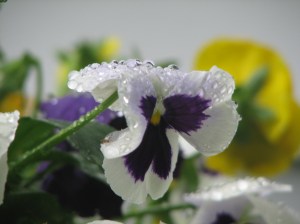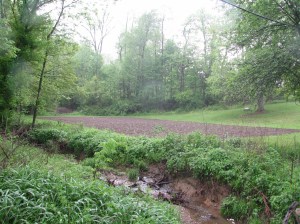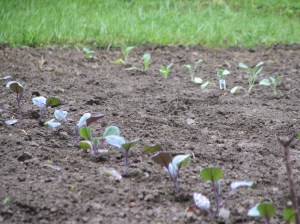The weather in southeast Indiana has been very wet this spring. Wet weather means wet ground, which means frustrated gardeners. I know because I was one until Friday, May 13th. How unlikely is it that Friday the 13th turned out to be my lucky day?
I have been pestering my husband for weeks about tilling the garden and his response has been “patience is a virtue.” I say that to him constantly so I deserved it this time. He reminds me what I already know…..if you work the ground too wet you will regret it for the entire growing season! Tilled too wet, the ground forms clods that cannot be worked out and seeds and roots need contact with soil to germinate and grow properly.
The tip for checking the soil is to use a shovel and dig as deep as you intend to work the ground. The soil should break apart easily and if it is shiny at all, you need to wait till another day to check again. My husband has been a farmer nearly all of his life and this advise always proves right.
He tilled it once the ground checked dry enough and then tilled again 2 more times the next day to help dry further. He tilled again to level everything out before we actually planted anything. I couldn’t wait to get started. I had everything we needed garden-side by the time he was finished tilling.
What do you need to plant?
Gardens come in all sizes and designs and this determines what you need. I am going to list the things I feel are needed to tend any size garden.
- rototiller-a tiller that is pulled by a tractor is wonderful to till gardens prior to planting and at the end of the season before you put the garden to bed for the winter. A hand tiller is necessary to maintain your garden once planted and throughout the growing season. It is important to keep the soil loose to encourage optimum growth. Most gardens need to be tilled at least once a week to remove weed growth. Weeds hinder plant growth by taking the nutrients, moisture, and space that the plant needs. Weeds can overtake a garden quickly and ruin your chances of getting a good harvest.
- hand tools: garden rake to move soil and gently cover seeds; hoe to space rows, remove weeds, dig planting furrows, and cover seeds; watering can to water transplants at planting time; garden gloves are optional but I find I wear them when using the hoe or rake and when pulling big weeds or when I pull plants at the end of their growing season.
- Row marker-It is important to have straight rows because this makes it easier to get a tiller between the rows throughout the season. A crooked row will plague you when the plants are at full maturity and blocking the aisle. I use two sticks of lumber or wood and tie a string between them long enough to cross the width of the garden so I can make sure the rows are straight. I mark lengths on the handle of my hoe to quickly space the distance between rows or plants. (1ft, 2ft, 3ft, 4ft, 5ft, 6ft). Make sure your rows are square to the garden so the sun will shine equally on both sides. Use individual row markers to designate where your rows are until the plants come up. Ready made markers can be purchased but I prefer to use wooden crafting sticks that I write the plant name on with a sharpie marker. These are inexpensive but functional and if they get tilled up accidentally ….no worries.
- Planting devices-I have an Earthway, Precision Seed Planter that saves a lot of time and back strain. It is a very manageable size, has hand holds, two wheels, a seed hopper, row marker and planting plow. There are several seed plates to use depending on the size of your seeds. The seed plate makes sure seeds are dropped at just the right distance from each other and a chain follows behind to cover the seeds once dropped. Of course you can also use a hoe to dig a shallow furrow and place the seeds in by hand, making sure to space them at the recommended spacing on the seed packet. Then use the hoe or rake to gently cover them with the recommended amount of soil.
The Process
Once the ground is tilled and the soil is fine and loose head to the garden with all your tools assembled. Use the wooden stakes and string to line up a straight row. I use my hoe handle to measure distance to keep the rows plum and true. You can use your eye to “sight out” a straight line, but I find my eyes a bit deceiving sometimes….
It is time well spent if you create a planting grid of your garden each year. Take time to think about the needs of all the plants you intend to grow and then determine where they would best have their needs met. It is also important to rotate the locations where vegetables are planted from year to year to help reduce diseases and maintain soil tilth. Different plants have different nutrient needs and planting the same plant in the same area year after year can deplete the soil of essential nutrients.
Many vegetables can be direct seeded into your garden. Once your grid is set begin planting rows maintaining the distance between rows as indicated by the seed packet. Lettuce, carrots, beets, beans, etc require much less distance between rows than zucchini and other types of squash or melons. Make sure to leave enough room at the end of the rows to get the tiller around. Use planting markers to designate what is planted where in the row. This is helpful until the seeds have germinated, but also if you need to check what variety of plant you planted for future reference.
There are a few garden plants that need to be started early in the spring to get the proper amount of growing time in order to harvest. In the Midwest, tomatoes, peppers, cucumbers, melons, cabbage, broccoli, cauliflower and eggplant should be planted as transplants. Mark rows and dig planting holes as recommended. Make sure the plants have been watered before you try to take them out of the pack trays or all the dry dirt will fall off the root pack. Gently invert the tray and push the plant out and place in the hole. Move some soil around the root ball to secure in place and if the soil is dry, water each plant then cover with remaining soil to secure the plant in the ground. Make sure there is not a well around plant stems or this could pool water and rot the stem. The best time to transplant is when it is cool and overcast or in the evening when the heat of the day is past. Don’t panic if your plants flag or appear to wilt for a day or two after planting. Transplanting, and hot and dry weather also cause stress. Within a few days from transplanting plants will begin to take off and grow once the roots have become established.
Fertilizing transplants is recommended to get them started. Compost or worm castings are natural materials that will feed the plants well. If you use commercial fertilizer use anything that has equal amounts of nitrogen, phosphorous, and potassium such as triple 12 or 15. Too much nitrogen will leach from the ground and can burn roots. Application can be made by mixing the fertilizing agent with the soil in the hole at planting, side-dressing the plants after planting, or watering the plants with a “fertilizing tea.” You may need to fertilize again during the growing season but be careful not to over-fertilize as this promotes green growth, not necessarily vegetable production.
After your garden is planted it will need to be tilled at least once a week in most cases to keep the soil loose and destroy the weed population. You will need to hoe between plants to help plants grow vigorously.
Once established some plants need to be staked, trellised, or mulched in order to produce the maximum. Peas and cucumbers thrive being trellised. A net provides support for the plants to secure themselves to. Tomatoes should either be staked or mulched well to prevent weed overgrowth and fruit rotting on the ground. Peppers have a tendency to get willowy and may benefit from staking, especially when they are heavy with fruit. If you grow string beans, you will need to provide a trellis or tripod for them to “run” on.
If you are new to gardening give it a try! Digging in the dirt is great exercise, gets you outdoors in the fresh air and sun, and for many, offers a great way to relax. Eating the food you grow is wonderfully rewarding and children are tempted to eat vegetables they have helped grow and pick… .
If you have specific questions, I will be glad to help you out. If I don’t know the answer, I know my husband will.




this post is very usefull thx!
So glad to be of help. Do you have anything specific that you would like to learn about?
Wow this is a great resource.. I’m enjoying it.. good article
Hmm is anyone else experiencing problems with the pictures on this blog loading? I’m trying to find out if its a problem on my end or if it’s the blog. Any suggestions would be greatly appreciated.